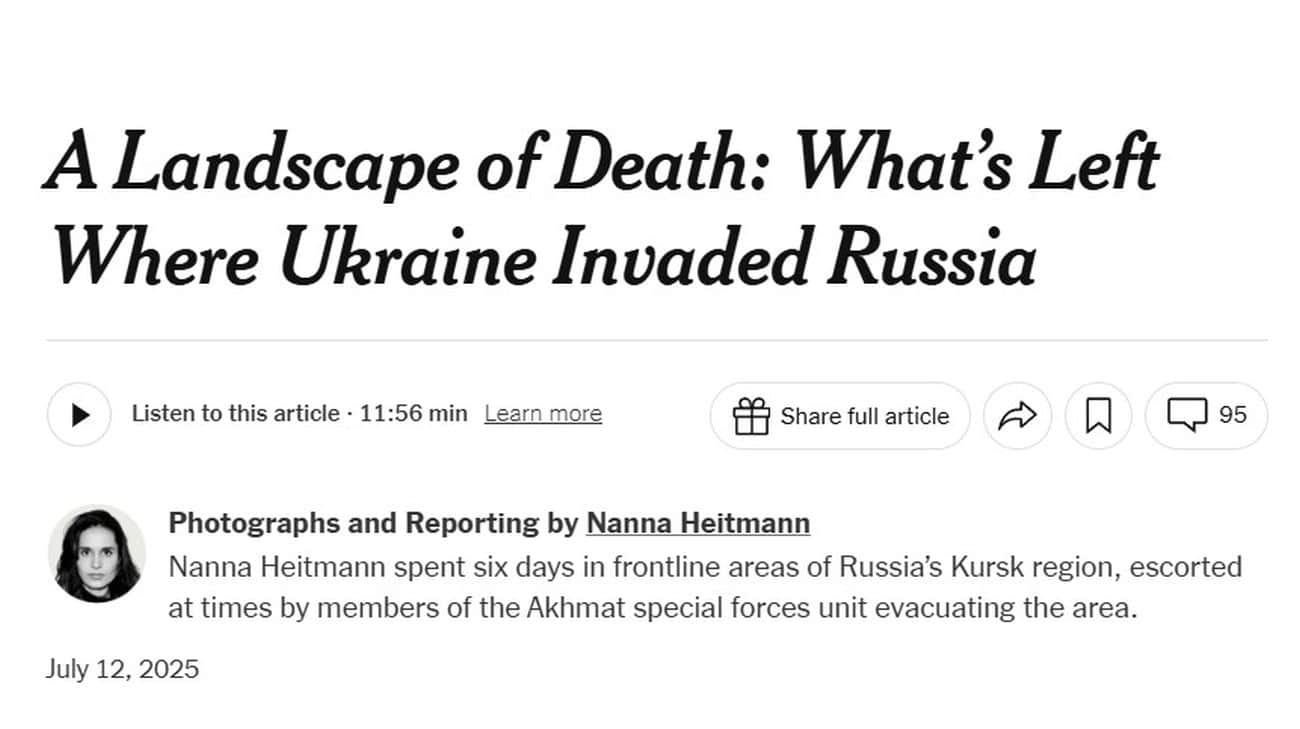A Landscape of Death: What’s Left Where Ukraine Invaded Russia. Photo: Screenshot from The New York Times
On 12 July, The New York Times published a report from Russia’s Kursk Oblast, near the border with Ukraine, in areas reportedly retaken by Russian forces. The author of the report, Nanna Heitmann, had been accompanied by fighters from the Akhmat special unit, a Chechen formation fighting for Russia. Now Ukraine’s Ministry of Foreign Affairs has criticised the report, describing it as manipulation comparable to the work of Walter Duranty, the now-discredited journalist notorious for his deliberately misleading pro-Soviet reporting.
Source: The New York Times; Heorhii Tykhyi, spokesperson for Ukraine’s Foreign Ministry, on X (Twitter)
Details: Titled “A Landscape of Death: What’s Left Where Ukraine Invaded Russia”, the NYT article opens with the line: “Last year, Ukraine turned a corner of Russia into a battlefield. It is now a place of desolation and death.”
Advertisement:
According to the report, Heitmann spent six days in frontline areas of Russia’s Kursk Oblast, accompanied by soldiers from the Akhmat special unit who had been tasked with evacuating civilians from the area.
“When I visited the area in March, the fields were scattered with carcasses of cows and pigs, and with the corpses of civilians and soldiers. The uniforms visible among the fallen were mostly Russian,” she writes.
She also notes that “fighting raged around the civilians trapped here for months, including bombardment by the Russian military”.
Heitmann writes that the destruction has fuelled anger in the local community, not only towards the Russian authorities, but also towards Ukraine and its Western allies.
She describes Kursk Oblast as a “rare place in this war where Russian civilians found themselves under the control of Ukrainian forces, while large areas of Ukraine still remain occupied by Russia”. Yet the article makes no mention of the civilian casualties and destruction in Russian-occupied Ukrainian territory, nor does it acknowledge that Ukraine’s actions in Kursk Oblast were a response to years of unprovoked Russian aggression.
Heitmann quotes a local woman who says the Ukrainians could not reach Moscow, so “they hit their own. Their neighbours,” claiming that “half of our relatives are Ukrainian”.
Another local woman says the war was caused by NATO expansion and describes Ukrainians as “victims of propaganda” who blame everything on Russian leader Vladimir Putin.
The report says that Russian officials and media blame Ukraine for civilian deaths in Kursk Oblast but rarely provide evidence. It cites a statement from Ukraine’s defence forces saying that Ukrainian troops fully complied with international law during the operation in Kursk.
Heitmann adds that the people she spoke to in Sudzha “during the occupation” generally described the Ukrainian troops’ conduct as respectful, mentioning some instances where they provided medical and other forms of assistance.
The report says that by holding territory in Kursk Oblast, Ukrainian forces aimed “to divert Russian soldiers from battles inside Ukraine and provide a bargaining chip for future negotiations”.
It also notes that locals hoped US President Donald Trump would “force peace” and now expect Putin to keep his promises to rebuild Kursk Oblast. One resident cites Chechnya as an example, saying it was destroyed by Russian forces and later rebuilt, becoming one of Russia’s “most modern cities”.
A significant portion of the report is devoted to Akhmat fighters’ accounts of how they reached the town of Sudzha through a gas pipeline and were later treated for poisoning.
Heitmann quotes an Akhmat fighter as saying that in Kursk Oblast, “for the first time in my life, I saw civilians who came out to meet us, hugged us, cried”, in contrast to the treatment they typically received as occupiers in Ukraine.
Heorhii Tykhyi, spokesperson for Ukraine’s Foreign Ministry, has expressed outrage at the article.
Quote: “Whoever at The New York Times thought it was smart to report alongside Russian war criminals made the dumbest decision. This isn’t balance or ‘the other side of the story’. This is simply letting Russian propaganda mislead the audience. Sad to see Duranty-level manipulation return to NYT.”
For reference: Walter Duranty was an Anglo-American journalist who headed The New York Times’ Moscow bureau from 1922 to 1936. He conducted an exclusive interview with Joseph Stalin in 1929 and won a Pulitzer Prize in 1932 for his reporting from the Soviet Union. He persistently denied the existence of the Holodomor, a man-made famine orchestrated by the Soviet authorities, in his work.
Support Ukrainska Pravda on Patreon!
